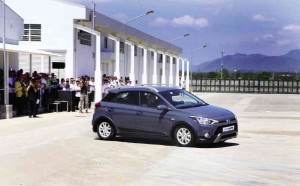When reputable environmental experts and advocates work together on a project, you can expect the “real deal” to come out of it.
A 10-hectare site on the Pan-Philippine Highway in Barangay Makiling, Calamba City, that used to be a textile factory, situated along the Mt. Makiling Forest Reserve and Tagaytay mountain ridge, has been converted into the Hyundai Logistics Center (HLC) which will house all Hyundai vehicles.
What makes HLC stand out is the level of involvement environment and sustainability experts and advocates have had on its development.
Architects Dominic Galicia, a historic site conservationist, and Mary Ann Aranas Espina, founding member of the Green Architecture Movement, dean of UP College of Architecture and principal of Espina, Perez-Espina and Associates, Architects, Landscape Architects, Environmental Planners, had been tapped by Hyundai Asia Resources Inc. (Hari), the official distributor of Hyundai vehicles in the Philippines, to be the lead architects for the project and the landscape design, respectively.
Architects Amado de Jesus, Philippine Green Building Initiative initiator and president, and Mel Punsalan, PGBI vice president for technical, were part of the PGBI group that rated HLC as a genuine ecodevelopment.
PGBI—formed by PRC-accredited professionals from the different organizations of architects and engineers, and heritage conservation societies—has been dedicated to developing a locally adopted rating system based on internationally accepted standards for green (environment-friendly and sustainable) buildings.
At its April 28 inauguration, HLC revealed data showing why it has been rated as a genuine ecodevelopment.
1 Adherence to a green rating system. HLC showed that it adheres to the guidelines of PGBI for sustainable development, which includes energy-efficiency and sustainability, water- and energy-efficiency and occupant well-being. Punsalan said that HLC has received the GREEEN Award from PGBI, rating the site as “Kamagong,” the highest distinction for green buildings.
“Kamagong is equal to platinum if we’re comparing this to other rating systems,” Punsalan said. GREEEN stands for Geared for Resiliency and Energy Efficiency for the Environment.
NOTE the minimal use of artificial light, resulting in overall savings of up to 52 percent in lighting energy costs.
PGBI is a group of professional development associations formed through the shared concern for the environment.
HLC’s rating of 87.5 percent is a prefinal points ration from the PGBI as of March 2015. Other PGBI ratings are “Molave” (70 to 84 percent); “Yakal” (55 to 69) and Narra (40 to 54).
2 Big energy savings. The facility uses only LED lighting fixtures, which reduces energy consumption up to 52.2 percent. Other areas, like the warehouse, use light monitors to capture natural light during daytime. A number of solar panels are also installed in some areas of HLC, with more to be developed.
3 Water facilities designed to reduce consumption. The HLC facility will enable Hari to reuse water from the car preparation areas, and also collect rainwater for siphoning, irrigation and other uses. It also treats wastewater to reduce environmentally harmful chemicals.
4 No trees cut during construction. Existing trees have been incorporated to the design, while existing walls, trusses and roads have been all kept and refurbished. High-quality materials were also used to minimize replacements.
5 Access to ventilation in the indoor spaces of HLC has been also made optimal for top-quality air exchange. The materials generate zero or reduced volatile organic compounds.
6 The landscape architects of Espina, Perez-Espina and Associates used the features of the HLC to fill it with greenery. First, through the use of roof gardens. These gardens reclaim the land that is occupied by the building footprint and brings more insulation to the buildings, reducing temperature in the area by up to 5 degrees Celsius.
7 HLC uses low-maintenance native grass (cogon) in its garden, and it also plans to reuse tires as grass containers.
8 HLC’s chapel garden, with high walls, were vegetated to bring more greenery. The green walls in and around the stockyard were vegetated with vines, including flowers. The green walls also create that visual harmony between HLC and its backdrop, Mt. Makiling.
Genuine vs ‘greenwashers’
As soon as environmentalism became mainstream in the early ’90s, its nemesis, the “greenwashers,” also reared its head.
Greenwashing refers to any act of misleading consumers about the environmental merits of a company, its products and services. De Jesus explained that it would also be considered greenwashing if a product or service is promoted as being good for the Earth without any basis in fact, which could lead to more harm on the environment, and on buyers of the product and service.
With the stamp of approval from PGBI, HLC seems to stand as far away as possible from this definition of greenwashers.
Plans for HLC to intensify the cause for sustainability is underway. The HLC Phase 2 project will house the Hyundai Academy (training facilities) and the Hari Center for Climate Change, where environment advocates will converge for further dialogue and studies to create solutions to the impact of climate change in the country. A car museum, which will house Hyundai classic cars, will have a green roof garden. The roofing of the stockyard will be solar panels.
Hari president and CEO Fe Perez Agudo said: “HLC is our pioneer and flagship endeavor that shows that we are serious about addressing the impact of climate change. It should set the standard for green buildings for the country’s automakers and distributors.”
